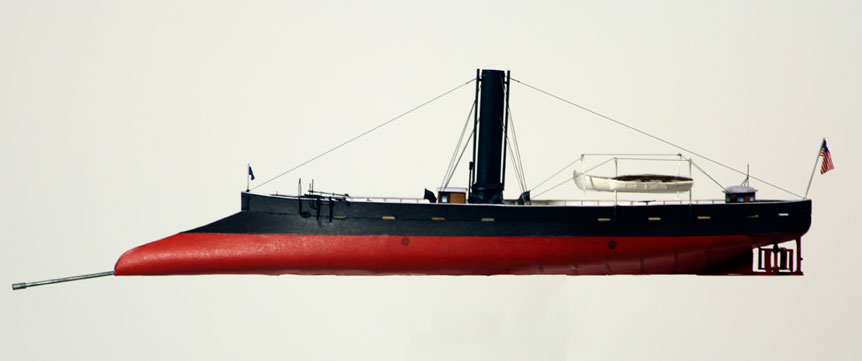
 Torpedo Boat U.S.S. "Alarm", 1874
Torpedo Boat U.S.S. "Alarm", 1874



On October 17, 1870 David Dixon Porter became Chief of the Bureau of
Navigation of the U.S. Navy. He brought with him a highly controversial vision
for the Navy’s future. Most officers and politicians had succumbed to “Monitor
fever” when the plucky little turret ship had appeared on the stage eight years
before, and few ships of other types had been built since the end of the Civil
War. But Porter knew the turret ships could not answer every challenge the Navy
faced. They were expensive and slow to build. Their low freeboards made them
notoriously poor sea-boats. Most of all, they were as vulnerable as the next
ship to spar torpedoes. This invention had deeply impressed Admiral Porter
during the Civil War, and he was determined to develop it to its full potential,
and against the opposition of the Monitor lobby.
A spar torpedo consists of a bomb on a long pole or spar, carried by a
small, fast, low-lying boat. Under the cover of night or fog the torpedo boat
stealthily approaches an enemy ship and detonates the bomb close to the
vulnerable underwater hull. This may sound simple enough in theory, but
experience had shown these missions to be suicidal under the best of
circumstances. Once detected, the little torpedo boats were highly vulnerable,
and even if the torpedo was deployed correctly, its charge was often too small
to cause any significant damage. Spar torpedo boats were, in the eyes of one
observer, little more than “a waste of good men.” Porter argued that modern
technology and improved design could improve the weapon’s reliability and
deadliness and make its deployment less dangerous. He envisioned a fleet of
lightly armored, agile boats designed with double-hulls and watertight
compartments to keep them afloat even when severely damaged; with sophisticated
electrical mechanisms to deploy and trigger the torpedo, and employing
telegraphy for shipboard communications. His design included a 15” Dahlgren gun,
the heaviest available at the time, in a fixed mount on the bow. A 24 foot long
ram prow projected forward. It contained the steam-operated torpedo mechanism.
The spar was to be deployed through a valve at the tip of the ram and would
project another 30 feet forward, placing the crew well out of danger from the
exploding torpedo. Additional torpedoes could be deployed through valves on each
beam. Gatling guns were mounted on the rail to fend of boarders. To make his
vessel as stealthy as possible, Porter designed the double hull to be flooded
until the spar deck was almost level with the water surface. The smoke stack
would telescope to half its height, and all deck structures were to be as low as
possible. Armor was to be light, and concentrated at the bow, for the ship was
to fight bows-on only. The vessel would approach her enemy by stealth, open up
with her massive gun, deploy her spar torpedo, and, if her victim still refused
to sink, deal a fatal blow with her ram.
With this design in hand, Porter applied to Congress for funds to build one
experimental vessel. Past Congresses had been famously economical when it came
to naval matters, but Porter did get $250,000 for two boats. The “Intrepid” was
designed by the Chief of the Bureau of Construction, Isaiah Hanscom and was
built at the Charlestown Navy Yard in Boston. Porter’s brainchild took shape at
the Brooklyn Navy Yard. In 1862 John Ericsson had named his turret ship
“Monitor” because he wanted it to be a monitor, that is, a warning sign for the
navies of the world. One can only imagine what Porter intended to communicate
when he named his vessel “Alarm.”
Both ships were commissioned in 1874 and commenced trials. The “Intrepid” turned
out to be a rather conventional craft that offered little innovation and was
soon mothballed. The Alarm, however, was radically different from any other ship
then in the U.S. Navy. She was constructed entirely of iron, the first American
ship with a complete double hull built on the transverse bracket system.
Electricity was used throughout the ship for lighting and communications,
another first. To provide superior speed and maneuverability she had received a
“Fowler Wheel”, an early cycloidal propulsion system, shaped like a four-bladed,
horizontal paddle wheel. By altering the angle of attack of the blades as the
wheel spun around, the pilot could change the direction of the ship instantly
without using a rudder. During trials it became apparent that the Fowler wheel
delivered only on the latter criterion: The Alarm spun like a top, but she was
dead slow. To add to the embarrassment it was soon discovered that the engines
had worked themselves loose from their bed-plates, necessitating extensive
repairs to the brand-new ship. For the next four years the Alarm carried out a
number of experiments at the Washington and New York Navy Yards, but mostly she
lay idle. Overall the experiment was seen as a costly failure. Public opinion
chided an overzealous Navy and Congress for spending freely on newfangled
inventions and unproven technology.
On June 11, 1878, Lieutenant R.M.G. Brown was put in command of the Alarm,
ostensibly to rescue what was left of her reputation. An enterprising and highly
successful navy officer, the energetic Brown immediately launched a publicity
campaign of newspaper interviews and public statements, extolling the unrealized
virtues of his ship. Against a public outcry of throwing good money after bad,
he successfully lobbied congress for $20,000 to replace the Fowler wheel with a
better system of propulsion. By July 1881 the newly invented Mallory Steering
Screw had been installed and once again the Alarm was undergoing trials in the
Hudson River. Alas, the Mallory screw did almost nothing to improve her snail’s
pace. In addition the 10-foot diameter of the Mallory screw had robbed the ship
of her shallow draft, which had been one of her saving graces. The press had yet
another field day. Undaunted, the Alarm conducted a series of experiments at the
U.S. Navy Torpedo school at Newport, R.I. She eventually returned to the New
York Navy Yard and was placed in ordinary. In 1891-92 she was converted to a
gunnery training ship. Surviving records show she was to receive six Hotchkiss
guns. However, it is not certain that these weapons were ever installed.
Certainly the Alarm does not appear to have served in this new role. Continuing
to deteriorate, she was struck from the Navy list in 1897. On February 23, 1898
the once formidable U.S.S. Alarm was sold for scrap